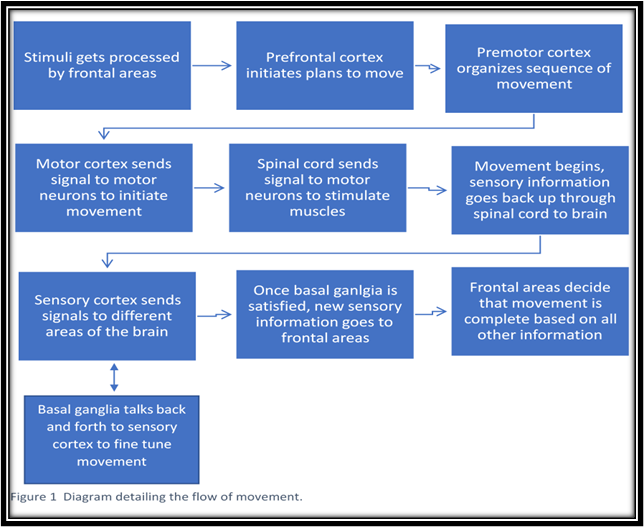It’s 2am and Robert needs to use the restroom but can’t gather enough strength to roll to a seated position to get out of bed without his wife’s help.
Gus decides to go to the kitchen for a snack but “freezes” when he reaches the doorway. His feet feel like they are stuck in mud.
Mary would like to attend her exercise class but the process of getting in and out of the car leaves her exhausted.
What do all of these people have in common? They have a progressive neurological disease called Parkinson’s Disease (PD). Parkinson’s Disease affects the dopamine-producing neurons in the substantia nigra (Latin for “Black Substance”, due to its darkened pigment in the brain). The substantia nigra contains the highest concentration of dopamine neurons. It is a part of the Basal Ganglia, an area that is responsible for motor control, motor learning, and procedural memory such as learning how to tie your shoes.
In PD, the onset of dopaminergic neuronal death in the substantia nigra manifests itself in the form of motor and non-motor symptoms that occur over a long period of time and in a progressive fashion. Most people are not aware they are presenting symptoms of PD until a loved one brings their attention to a tremor, lack of arm swing, or notices a series of falls.
People living with Parkinson’s Disease want to take larger steps, smile more, swallow food without fear of choking, dress and bathe themselves, drive and participate in social activities.
However, for some, when they have a thought such as “I want to walk to the kitchen for a snack”, getting the thought to become an action, is almost impossible due to the lack of dopamine neurons in the Substantia Nigra. But wait a minute! HOW does a thought even become an action and WHAT can a Fitness Professional do to improve brain and body connection?
How a thought becomes an action
The brain is constantly multitasking as it takes in stimuli from your surroundings, interprets what’s going on around you and causes you to take action. When your mind creates a conscious thought, such as “I want to get a snack”, a chain reaction takes place in the brain involving several areas. This starts in the frontal areas of your brain after processing the stimuli leading to the thought. For example, if you have your eyes set on the kitchen to get a snack, your prefrontal cortex initiates plans to make the movement, sending signals to your premotor cortex to organize those plans, and then sends those signals to the motor cortex to carry out the movement.
Once the movement has been planned and the best course of action has been “decided” by these neurons, the movement can commence. This creates the surge of neuronal firing from the motor cortex through the spinal cord to motor neurons that communicate with muscles and finally manifests the movement.

The above seems straightforward. The tricky part is regulating all of those different areas. Once the gross movement is executed, sensory information ( i.e. touch, temperature, or force) travels back up to the brain through sensory neurons in the spinal cord. The sensory cortex receives and carries the message to other parts of the brain that fine-tune the movement. This is one of the functions of the basal ganglia and other areas in the midbrain.
Because you’ve most likely done these types of movements before, those patterns are all stored in the basal ganglia so it doesn’t take up valuable space in the motor cortex. This area talks back and forth to the frontal areas to figure out what specific pattern should be used to achieve the best result. There are a hundred different ways to get out of a chair and go to the kitchen, but the basal ganglia works together to choose the most efficient option out of all of them and keeps the movements from getting out of control so you’re not high knee-ing to the kitchen when a simple walk will do (unless you want to high-knee to the kitchen). Once everything is adjusted and looks correct, new sensory information goes to the sensory cortex and back to those frontal areas to then signal that the movement has been fully executed.
Now, although that looked like a lot of steps just to complete one movement, this all happens within a fraction of a second, and is constantly going as you move to correct and adjust. The process is fluid, but works as a chain. If one link is broken, the rest of the process is going to fall apart. So how is the link broken in a disease like Parkinson’s?
Because the basal ganglia gets a lot of communication from the substantia nigra, if there is a loss of any sort of dopamine neurons, the relay of information gets discombobulated and, in the case of Parkinson’s, causes the motor system to stop the movement mid-way as there is not enough information from the neurons firing. Instead of creating the controlled movements and fine motor adjustments like you would see in a regular motor response, you have freeze-ups where the frontal areas are telling the midbrain to do one thing, and the basal ganglia just can’t do what it’s being told to do. Thus, the chain of movement is broken and the body cannot execute the action properly. To most, it looks like people with PD can’t seem to execute an action because of cognitive reasons. However, from their perspective, they want to be able to execute it and are consciously telling themselves to do it, but part of their brain isn’t “listening” and it causes the brain and body to be disconnected, resulting in incomplete movements and motor symptoms such as resting tremor, freezing of gait, and rigidity. This is why when PD patients take their medications, which help the brain to produce dopamine, they have “on” periods where these areas are able to have clearer communication with each other, their movements are better and their symptoms are better managed.
This is critical information for Fitness Professionals working with people living with Parkinson’s Disease. Once the information is understood, Fitness Professionals can focus on the second question which is “What can a Fitness Professional do to improve the brain-body connection for those living with Parkinson’s Disease?”
First, remind them that Exercise is Medicine! They need to take a dose each and every day! And the good news is that exercise provides outcomes such as:
- Improved neuro-protection for at-risk dopamine neurons
- Neuro-repair for areas of the brain affected by Parkinson’s Disease, and
- Adaptation by retraining areas of the brain to pick up where the damaged parts can no longer execute commands.
Second, determine the activities of daily living (ADLs) that are most difficult for them. Identifying the ADLs and providing an exercise program that includes the seven functional movement patterns (push, pull, carry, hinge, lunge, squat and rotation) to improve their ability may save their lives. Repetition will be the key to create a spirit of confidence!
In Part 2, I discuss the three ADLs considered by most people living with Parkinson’s Disease to be most difficult, and exercises to complement them.
Colleen Bridges has worked for nearly 17 years as an NSCA Certified personal trainer, group exercise instructor and fitness consultant and as an independent contractor for Nashville’s first personal training center, STEPS Fitness. Her passion for understanding the body in sickness and in health, and how it moves, as fed her interest in and enhanced her talent for working with senior adults, especially those living with a neurological disorder such as Parkinson’s Disease.
Renee Rouleau is a Clinical Research Coordinator for the Department of Neurology at Vanderbilt Movement Disorder. Her research primarily focuses on the glymphatic system, a proposed waste-clearance system in the central nervous system in different neurodegenerative disorders such as Parkinson’s Disease (PD) and Alzheimer’s Disease (AD).


